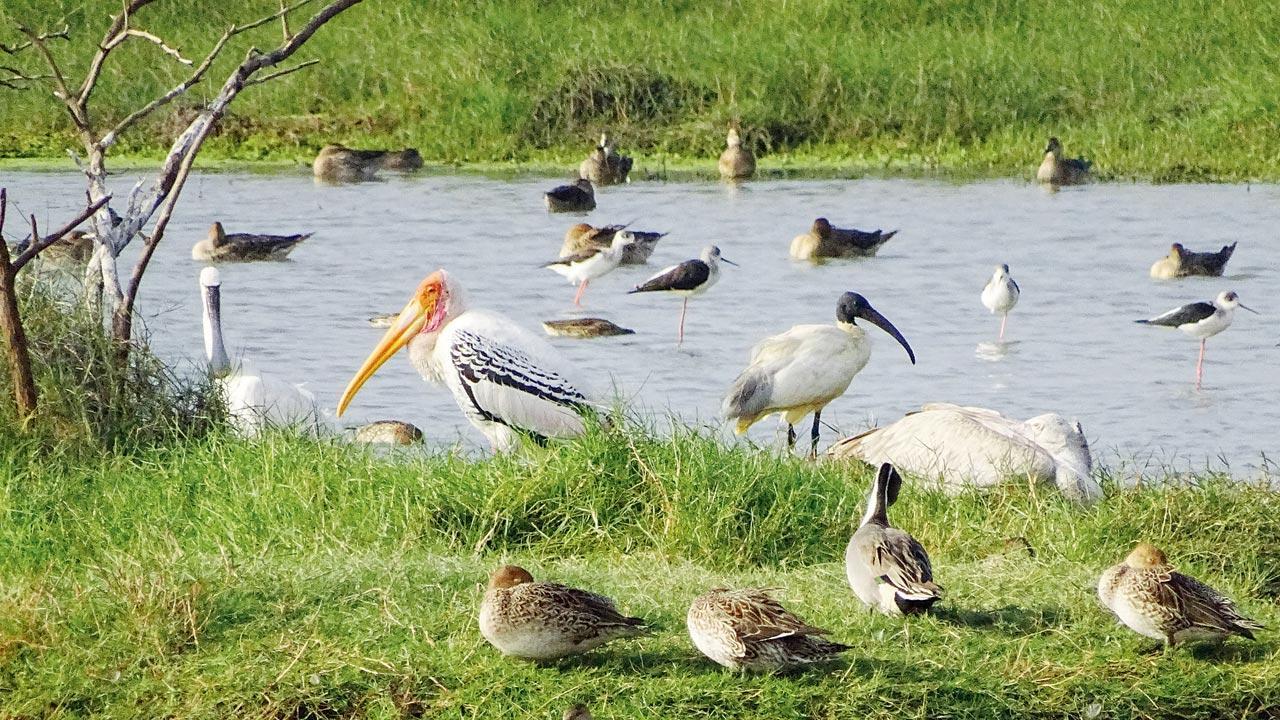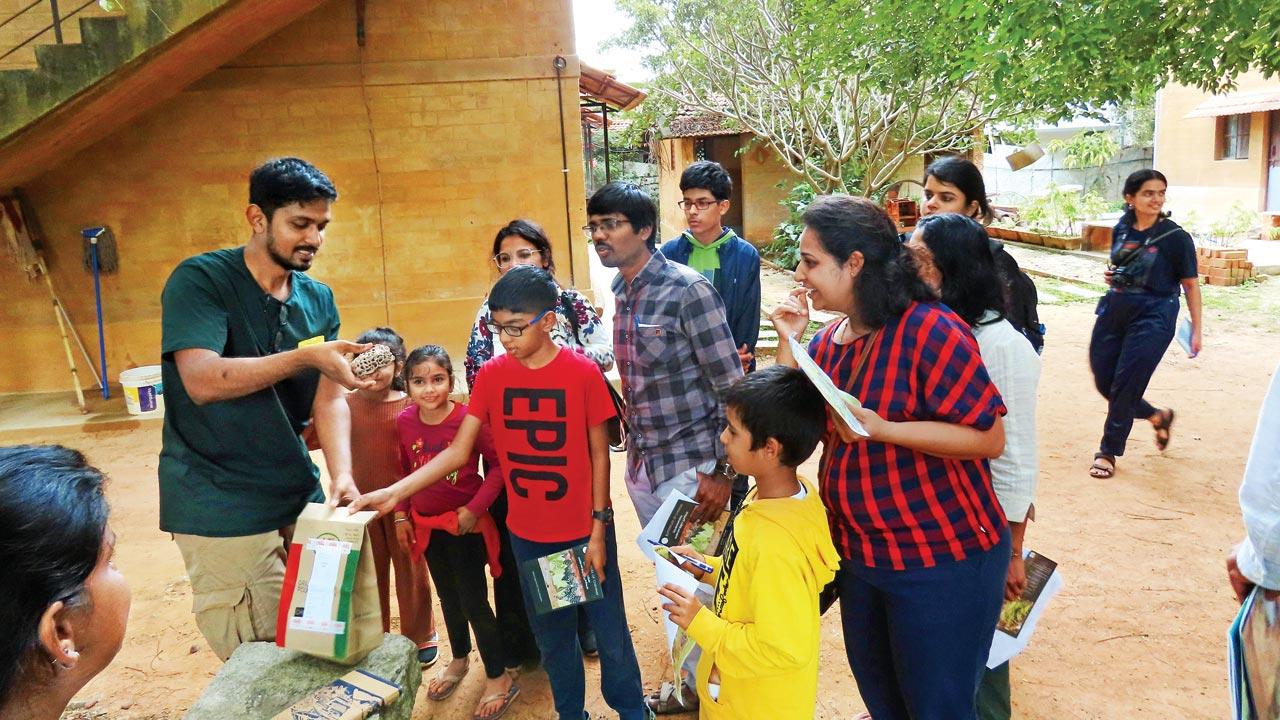Born of a disturbed childhood, a naturalist’s approach to other species and nature asks us to go beyond the mindscape-landscape binary

Chennai’s wetlands offer a multispecies landscape
![]() Cities emerge around hydrologies. Sometimes, they remember their bedrock and live for long. And at other times, they forget their watery genesis and collapse under their own weight: this is Yuvan Aves’ powerful sentiment in the new book Intertidal: A Coast and Marsh Diary (Bloomsbury Publishing). The renowned naturalist-educator-climate literacy activist writes about Chennai, but his observations on the land-water imbalance apply as much to Mumbai, or rather, to all of the 25-odd Indian cities situated on India’s 7517 km long coastline.
Cities emerge around hydrologies. Sometimes, they remember their bedrock and live for long. And at other times, they forget their watery genesis and collapse under their own weight: this is Yuvan Aves’ powerful sentiment in the new book Intertidal: A Coast and Marsh Diary (Bloomsbury Publishing). The renowned naturalist-educator-climate literacy activist writes about Chennai, but his observations on the land-water imbalance apply as much to Mumbai, or rather, to all of the 25-odd Indian cities situated on India’s 7517 km long coastline.
Aves’ diary of daily musings goes beyond the Chennai geography. He refers to the city’s high exposure to hydromet disasters, particularly flood and cyclone events. Statistical data shows that Mumbai is close behind, as the second-most affected in this category. As witnessed in July 2005, Mumbai is extremely vulnerable to sea level rise, coastal erosion and strong weather events which are exacerbated by the climate. Aves is pained by the numerous coastal development projects—from ports to roads—which threaten the intertidal ecosystem and artisanal fishing communities of cities. He feels all city spaces must primarily be perceived as waterscapes, where the integrity, function and health of wetlands is given utmost importance.
ADVERTISEMENT
He will soon launch Intertidal in Mumbai and at other venues, wherever readers care to see, feel, sense, and discover the rhythms of the natural world. The 1995-born nature educator was recently at the Jaipur Literature Festival, not just to speak of his book, but also deliberate with other celebrated naturalists who heed climate’s call.
 Yuvan Aves talking to children and parents during an insect walk
Yuvan Aves talking to children and parents during an insect walk
Candidly and honestly, Aves says that he writes for “young people who are moving away from old political, religious and cultural values that have proved to be ecologically disastrous.” His book is for coasts, wetlands and all their life, and for friends fighting to protect them. Fittingly, he believes a cultural shift in perspective can be brought about by civic action.
Page after page, at every opportune juncture, it celebrates environmental activists who have given their lives to save wilderness. For instance, dear to Aves is Nityanand Jayaraman who is fighting Hindustan Unilever for allegedly poisoning Kodaikanal’s fauna and people with mercury. Aves casts a wide net for new updates and insights, reaching out to people like Hong Kong-based marine biologist Dr Jay Minuti—an expert on oyster reef restoration.
Intertidal also underlines the uncertain and scary future of India’s coastline. The starkness of the data may lead to gloom, but the book offsets this despondency by energising the reader with a possibility—of an everyday connection with the under-noticed living beings around humans. Aves shares an extraordinary feeling of fellowship towards a number of species, from guitar fish and seagulls, to carpenter bees, lugworms, fiddler crabs, diving beetles, orange-headed thrush, potter wasps, reed warblers, blue-lined snappers, marsh-trotters—you name it. The book demonstrates a simple truth: you don’t need to be an ecologist to be witness to ants, crows, trees, rain and morning skies. Intertidal grants a legitimacy to attentive observation of life-sustaining forms; it signals those rushing through life and deadlines to slow down. It also reminds us that cities are inherently multi-species spaces, not just residences for humans.
 Yuvan Aves
Yuvan Aves
Aves’ approach is observational and action-oriented, manifesting in campaigns, rallies and civic action programs, including collaborations with the fisher communities of Urur Kuppam and other beaches. He is part of the Madras Naturalists’ Society (MNS), through which he institutes an internship for young educators in life sciences and nature. Through Fridays for Future India, he waged campaigns to save wild spots which were being cleared, especially during the COVID-19 pandemic. Every year, he participates in the Chennai climate rally for the rights of fishers, labourers, and marginalised communities. He is also involved in the MNS survey of coastal biodiversity hotspots in Tamil Nadu like the Pulicat Lagoon, Adyar Estuary, and Kovalam Creek. Some of these threatened climate sanctuaries have also been the author’s own ecological terrain; his home turf since birth.
Aves’ first book, A Naturalist’s Journal, also drew from the local landscape. The second is more fastidious in its daily records of three monsoons, from 2020 to 2022. It is a powerful documentation of a city marred by cyclones, flooding, power cuts, and chaos on the streets, against the backdrop of Urur Kuppam beach and other marshlands, The author reels under the scarring memories from December 2015 (much like the July 2005 downpour and flooding in Mumbai) when Chennai was underwater for days. Aves took shelter in an ark at the Pathashaala school in rural Chengalpattu district. He was in the company of two colleagues, two barred wolf snakes, a common sand boa, colonies of black ants, field crickets and others displaced by the floods. The large-scale catastrophe, a result of poor urban planning and abject disaster management, triggered his deeper search for an intertidal, non-binary connection between the self and the city’s climate.
For Aves, a daily journal is like “my daily sacrality, my animistic practice”—an opportunity for looking outwards and inwards. His keenness for wildlife and nature stems from a disturbed childhood. After years of neglect by his biological father, Aves’ parents separated and his mother moved in with another abusive man. Made to perform domestic duties, he was stopped from attending school. The time he spent in the marshland of Madipakkam became a refuge from the violence at home. When he turned 16 in 2011, he ran away from home and was embraced by the Pathashaala residential school under the Krishnamurti Foundation, on the banks of the Palar river. It was here that Aves developed his deep bond with other species.
He rejoiced in the company of rivers, lakes, reserve forests and paddy fields. Nature writers M Krishnan, Robert Macfarlane and Annie Dillard became his everyday-but-distant mentors who helped to recast his woes into energy that moulded his very life. Today, some of them are his fellow travellers, living in different corners of the world but within the reach of a message. Macfarlane praises Intertidal as a wondrous work of “walking, seeing, and thinking.” He compares it to Nan Shepherd’s classic memoir, The Living Mountain, because of its intensity of vision and a democratic, inclusive account of ecology. Aves’ work thus resonates far beyond Chennai’s water bodies!
In a sense, Intertidal was a demanding read—one that calls for attention to minute details; comments on displaced, altered and threatened locales and disastrous infra projects; as well as references to the debates of the day on the environment. Aves captures all of the above elements in an am-to-pm diary entry format while retaining the lyrical quality of each entry. A dragonfly fallen in a tadpole tank, freshly metamorphosed frogs perched on matted algae, Brahminy Kites circling overhead, egrets and sand plovers standing in the swash zones foraging wedge clams—worlds within worlds which unfold magic. Aves has a pocket book ready for every hour, be it a koel’s 4.45 am call during the summer, sunlit pelicans flying towards the Kallu Kutai lake, or thousands of crimson rose butterflies flying south towards Sri Lanka with the north east monsoon’s arrival. The author also documents his own personal time and ‘friendships’ with natural elements. For instance, the Great Adyar Banyan near the Theosophical Society stone gate is like a family member. Aves visited the banyan after his sister’s death. “I could cry to it safely, a grief I had not poured anywhere,” he recounts in the book.
Intertidal recommends meditative, sensorial tours to the reader—not just by way of visits to the coast and wetlands or any water body, but through a search for a zone where all binaries dissolve: mind-body, male-female, land-water, good-bad, joy-grief, pain-pleasure, living-non-living, I-other.
Aves recommends that the reader try intertidal meditation at a beach, preferably at low tide, and I immediately imagined myself at Dadar Chowpatty. I thought of the noise levels that I wouldn’t be able to escape, and also of the tremendous resolve it would take to disregard dabeli sellers, bhutta eaters, couples taking selfies, masseurs, and tonga gadi revellers. I asked the author about how he focuses as the city passes by. He says meditation implies “complete witnessing and attention—which merges us with the aliveness which always surrounds us, atmosphere, hydrosphere, biosphere.” I take his word and turn to the Mumbaiscape within me.
Sumedha Raikar-Mhatre is a culture columnist in search of the sub-text. You can reach her at sumedha.raikar@mid-day.com
 Subscribe today by clicking the link and stay updated with the latest news!" Click here!
Subscribe today by clicking the link and stay updated with the latest news!" Click here!








